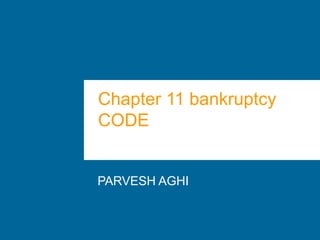Melden
Teilen

Empfohlen
Empfohlen
Weitere ähnliche Inhalte
Was ist angesagt?
Was ist angesagt? (16)
Revised Corporation Code Philippines - Voting Requirements SUMMARY

Revised Corporation Code Philippines - Voting Requirements SUMMARY
Module 1 -Real Estate Principles and Practice October 2015 

Module 1 -Real Estate Principles and Practice October 2015
Ähnlich wie Chapter 11 ppt
Ähnlich wie Chapter 11 ppt (20)
Navigate Chapter 11 Bankruptcy With Attorneys Of Sullivan County.pptx

Navigate Chapter 11 Bankruptcy With Attorneys Of Sullivan County.pptx
What is bankruptcy What are the different types of bankruptcy Do y.pdf

What is bankruptcy What are the different types of bankruptcy Do y.pdf
It's Only Money? How Your Clients Can Keep More of It When Customers File Ba...

It's Only Money? How Your Clients Can Keep More of It When Customers File Ba...
How to Decide if 7 or 11 is the Right Bankruptcy Choice

How to Decide if 7 or 11 is the Right Bankruptcy Choice
Bankruptcy Basics – Understanding Your Client's Options - Tully Rinckey PLLC CLE

Bankruptcy Basics – Understanding Your Client's Options - Tully Rinckey PLLC CLE
Brian Linnekens gives an insight on Different Types of Bankruptcy

Brian Linnekens gives an insight on Different Types of Bankruptcy
Chapter 11 ppt
- 2. What is Bankruptcy? » Bankruptcy is a federal court process that helps individuals and businesses repay their debts under the protection of the bankruptcy court (Chapter 13 Bankruptcy) or wipe their debts out altogether (Chapter 7 Bankruptcy). » When you file for bankruptcy, an automatic stay goes into effect which prohibits your creditors from taking action to collect the debt without the approval of the court 2
- 3. » There are two basic types of bankruptcies: » liquidation or reorganization. » In the US, liquidation is known as Chapter 7 Bankruptcy, which refers to the chapter of the bankruptcy law that allows your assets to be sold off (liquidated) to pay creditors. » Reorganization is most commonly known as Chapter 13 Bankruptcy. 3
- 4. » Chapter 11 is a chapter of the United States Bankruptcy Code, which permits reorganization under the bankruptcy laws of the United States. » Chapter 11 bankruptcy is available to every business, whether organized as a corporation or sole proprietorship, and to individuals, although it is most prominently used by corporate entities.
- 5. » In contrast, Chapter 7 governs the process of a liquidation bankruptcy, while Chapter 13 provides a reorganization process for the majority of private individuals. 5
- 6. » Chapter 11 is one of the chapters of the US Bankruptcy Code that provides protection to debtors. » Chapter 11 bankruptcy is almost exclusively used by businesses due to the expense and complexity of the process. » Chapter 11 bankruptcy is appropriate when a business needs to restructure the debts it has and reorganize its finances so it can stay open.
- 7. » As an alternative to Chapter 7, which would require a business to liquidate, Chapter 11 allows a business to keep many of its assets. 7
- 8. » Chapter 11 bankruptcy involves the financial reorganization of a business, which may be a complex and extensive process. » As soon as a company files for Chapter 11, all collection activities must cease. This stay will remain in effect throughout the bankruptcy process.
- 9. » The process of Chapter 11 begins with the creation of a plan. » The debtor or debtors involved may propose the repayment and reorganization plan or, after a period of time (usually around 120 days), the creditors may propose a plan as well. » The plan may allow the debtor to cancel contracts. » The value of shares owned if the stock is publicly traded may also be cancelled, leaving the shareholders with nothing.
- 10. » Any plan that is created must be approved by the creditors, and if there are multiple plans sometimes the creditors are given the opportunity to vote on the plan that is put into place. 10
- 11. » A trustee will be involved throughout the reorganization process as well. » The trustee will help to ensure that priority claims are paid, that assets are managed properly, and that the reorganization proceeds as it should. » If the owners are not managing the assets properly, the trustee may take more control or someone else may be put in charge of the assets.